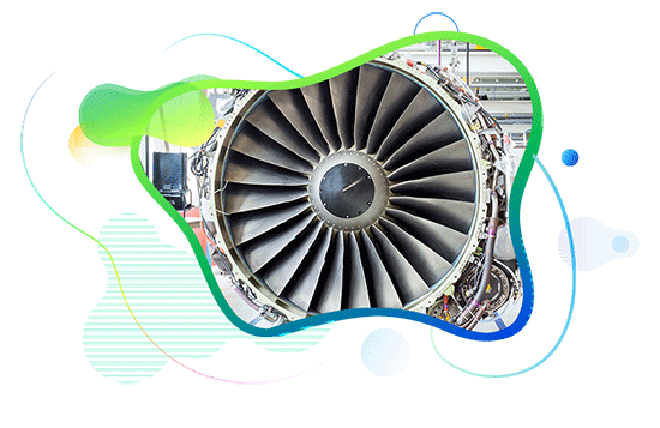
- Home
- Ramco Analytics Suite Aviation
- Measuring Aviation MRO Supply Chain through SCOR® Processes and Metrics
Measuring Aviation MRO Supply Chain through SCOR® Processes and Metrics
Published :
Supply Chain Operations Reference (SCOR®) framework is adopted by organizations to measure, manage and benchmark the performance of the supply chain. SCOR process and metrics are broad based and can be adapted to any industry or application. As Aviation Maintenance Repair & Overhaul (MRO) is a service, measuring the supply chain management through SCOR framework will open a new perspective for managing the chain.
Aviation MRO’s business objective is to fulfill the customer orders. SCOR identifies the unique processes that a supply chain requires to support the objective. For MRO, the customer is normally the aircraft operator and the supplier is Original Equipment Manufacturer (OEM) / Distributors.
Plan (P): Planning activities associated with the aviation’s supply chain. In MRO, it includes forecasting customer requirements and managing the existing capacity. Identify the bottleneck capacities like hangar space, special tools or kits, etc... and plan to augment them.
Source (S): This mainly includes the ordering, transshipments, arrangements through freight forwarders, imports clearance, receiving & inspection, and binning & invoice processing. It also includes the contractual agreements for bulk purchases, maintaining the price vendor price catalog & quotes processing.
Make (M): As per the SCOR, creation of content for services is also considered as Make. It includes the aviation maintenance execution of repair / overhauls of engine & components at the shops and line & base checks of aircrafts.
Deliver (D): This includes accepting the customer order, communicating the additional work scope and work progress or delay, packing and shipments, exports, getting acknowledgement of customer service, and invoicing the customer.
Return (R): Customer can return the item back if it fails its inspection process. Similarly, the MRO should return the procured item from the supplier if it fails in the inspection. Warranty tracking for both the customer returns and for the supplier returns are included.
Selecting the Key Performance Indicators (KPI) and building a scorecard is a vital step for an organization to measure and manage. SCOR identifies five core supply chain performance attributes with three levels of metrics. It also recommends scorecards should at least have one metric for each performance attribute to ensure balanced decision making.
Following is a typical scoreboard for Aviation MRO with Level-1 metrics:
|
Performance Attribute |
Level-1 KPI |
Definition and Key Processes |
|
|
Customer Facing |
Supply Chain Delivery Reliability |
Perfect Order Fulfillment |
|
|
Supply Chain Responsiveness |
Order Fulfillment Cycle Time |
|
|
|
Supply Chain Agility |
Supply Chain Flexibility |
|
|
|
Internal Facing |
Supply Chain Cost |
Supply Chain Management Cost |
|
|
Supply Chain Asset Management |
Return on Supply Chain Fixed Assets |
|
It’s a known fact that what cannot be measured cannot be managed. In an integrated MRO aviation set up, setting up the KPI and measuring it is vital for achieving desired overall business objective. Ramco Aviation Suite of M&E/MRO Solutions integrated with Ramco Aviation Analytics has the flexibility of configuring various KPI’s of SCOR which helps MRO Aviation to measure, manage, improve and benchmark various processes.
SCOR® model is the product of Supply Chain Council (SCC) and is a registered trademark in the United States and Europe.
Blog by: S. Saravanan Rajarajan, Senior Consultant, Ramco Systems
Enterprise asset management (EAM) involves the management of mission critical assets of an organization throughout each asset's lifecycle. EAM is used to plan, optimize, execute, and track the needed maintenance activities with the associated priorities, skills, materials, tools, and information. The aim is to optimize the quality and utilization of assets throughout their lifecycle, increase productive uptime and reduce operational costs.
Enterprise asset management (EAM) involves the management of the maintenance of physical assets of an organization throughout each asset's lifecycle. EAM is used to plan, optimize, execute, and track the needed maintenance activities with the associated priorities, skills, materials, tools, and information.
The software helps in effective maintenance of assets through preventive, predictive, shutdown and breakdown maintenance strategies. The system also helps enterprises mitigate equipment risks by enhanced safety standards. The streamlined operations and improved asset performance helps organizations increase their investment effectiveness.
EAM is important because it helps organizations track, assess, manage and optimize asset quality and reliability. Asset intensive Organizations have hundreds, thousands, even millions of assets which needs to be maintained to maximize / optimize life of these assets to increase the return on investment.
The key features of effective EAM are:
Asset Intensive companies under the following Industries :
Contact us for a meeting and schedule a demo
This differs on case to case basis, based on the type of installation and unique industry specific requirements. Contact us for a meeting and schedule a demo.
This differs on case to case basis, based on the type of installation and unique industry specific requirements. Contact us for a meeting and schedule a demo.
Stay Connected, follow us on LinkedIn / Twitter to know more about EAM Software latest trends.

All Rights Reserved. © Copyright 2024. Ramco Systems.